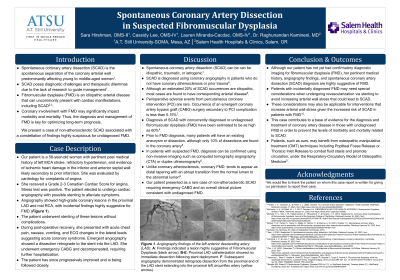Back

Clinical: General Topics
Case Report: Spontaneous Coronary Artery Dissection in Suspected Fibromuscular Dysplasia
Friday, March 31, 2023
12:00 PM East Coast USA Time


Sara Hirshman, OMS-II (she/her/hers)
ATSU-SOMA
Bend, Oregon, United States
Presenting Author(s)
Introduction: Spontaneous coronary artery dissection (SCAD) is the spontaneous separation of the coronary arterial wall predominantly affecting young to middle-aged women. SCAD management is challenging due to lack of guidance. Fibromuscular dysplasia (FMD) is an idiopathic arterial disease that can present with SCAD. Coronary involvement with FMD may significantly impact morbidity and mortality. Thus, the diagnosis and management of FMD is key for optimizing long-term prognosis. We present a case of SCAD in a patient highly suspicious for undiagnosed FMD.
Case Study: Our patient is a 58-year-old woman with pertinent past medical history of left MCA stroke and refractory hypertension. She was evaluated by cardiology for complaints of angina and elected to undergo cardiac angiography with possible stenting to alleviate her symptoms. Angiography showed high-grade coronary lesions in the proximal LAD and mid RCA, with incidental findings highly suggestive for FMD. The patient underwent stenting of these lesions without complications. During post-operative recovery, she was found to have a dissection retrograde to the stent into the LAD. She underwent emergency CABG and decompensated, requiring further hospitalization. The patient has since progressively improved and is being closely followed.
Discussion: Perioperative adverse events from percutaneous coronary intervention (PCI) are rare, with the occurrence of an emergent CABG from PCI complication being less than 0.15%. Although an estimated 20% of SCAD occurrences are labeled as idiopathic, most cases are found to have corresponding arterial disease. FMD is an idiopathic, non-inflammatory, non-atherosclerotic arterial disease. Estimates for patients with SCAD who concurrently have diagnosed or undiagnosed FMD was found to be as high as 60%.
Our patient presented with non-atherosclerotic coronary artery dissection secondary to undiagnosed FMD. Although our patient has not yet had confirmatory diagnostic imaging for FMD, her pertinent medical history, angiography findings, and SCAD are highly suggestive of FMD. Patients with suspected FMD found incidentally may need special considerations when undergoing revascularization via stenting. These considerations may also be applicable for interventions that increase arterial wall stress given the increased risk of SCAD in patients with FMD. This case contributes to a base of evidence for diagnosis and treatment of coronary artery disease in women with undiagnosed FMD in order to prevent the occurrence of SCAD. These patients may benefit from treatment techniques including Popliteal Fossa Release or Thoracic Inlet Release to combat fluid stasis and promote circulation, under the Respiratory-Circulatory Model of Osteopathic Medicine.
Case Study: Our patient is a 58-year-old woman with pertinent past medical history of left MCA stroke and refractory hypertension. She was evaluated by cardiology for complaints of angina and elected to undergo cardiac angiography with possible stenting to alleviate her symptoms. Angiography showed high-grade coronary lesions in the proximal LAD and mid RCA, with incidental findings highly suggestive for FMD. The patient underwent stenting of these lesions without complications. During post-operative recovery, she was found to have a dissection retrograde to the stent into the LAD. She underwent emergency CABG and decompensated, requiring further hospitalization. The patient has since progressively improved and is being closely followed.
Discussion: Perioperative adverse events from percutaneous coronary intervention (PCI) are rare, with the occurrence of an emergent CABG from PCI complication being less than 0.15%. Although an estimated 20% of SCAD occurrences are labeled as idiopathic, most cases are found to have corresponding arterial disease. FMD is an idiopathic, non-inflammatory, non-atherosclerotic arterial disease. Estimates for patients with SCAD who concurrently have diagnosed or undiagnosed FMD was found to be as high as 60%.
Our patient presented with non-atherosclerotic coronary artery dissection secondary to undiagnosed FMD. Although our patient has not yet had confirmatory diagnostic imaging for FMD, her pertinent medical history, angiography findings, and SCAD are highly suggestive of FMD. Patients with suspected FMD found incidentally may need special considerations when undergoing revascularization via stenting. These considerations may also be applicable for interventions that increase arterial wall stress given the increased risk of SCAD in patients with FMD. This case contributes to a base of evidence for diagnosis and treatment of coronary artery disease in women with undiagnosed FMD in order to prevent the occurrence of SCAD. These patients may benefit from treatment techniques including Popliteal Fossa Release or Thoracic Inlet Release to combat fluid stasis and promote circulation, under the Respiratory-Circulatory Model of Osteopathic Medicine.
